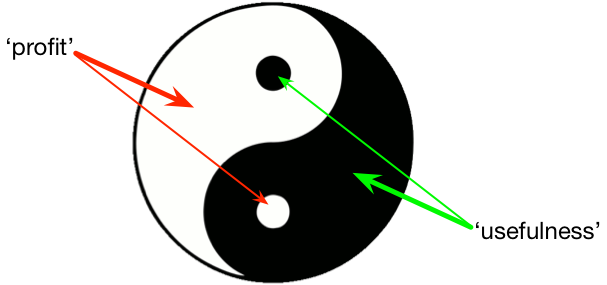Architecting the balance between usefulness and profit
One of the constant challenges for enterprise-architecture – probably all forms of architecture, in fact – is explaining the value of what we do. For example, like a good conference-organiser or event-host, often the better we do our work, the less visible it becomes. Often the only way we can see this invisible work in an enterprise is when two or more business-teams are claiming credit for the same thing: for that to happen, it means that there’s a good architecture there that created the otherwise-invisible bridge between them.
Yet how do we make the invisible more visible – without doing so by showing up only its failings? One option might be to go back to a very old description of much the same kind of theme – Chapter 11 of Lao Tse’s Tao Te Ching, in the modern translation by Gia Fu Feng and Jane English:
Thirty spokes share the wheel’s hub;
It is the center hole than makes it useful.
Shape clay into a vessel;
It is the space within it that makes it useful.
Cut doors and windows for a room;
It is the holes which make it useful.
Therefore profit comes from what is there;
Usefulness from what is not there.
Both ‘profit’ (whatever that is, but contextually determined) and ‘usefulness’ (likewise) kind of weave and twist and turn continually around each other – or, as another more modern poet put it, again quoting an earlier age:
… In daunsinge, signifying matrimonie—
A dignified and commodiois sacrament.
Two and two, necessarye coniunction,
Holding eche other by the hand or the arm
Whiche betokeneth concorde.
The two need to balance each other, support each other; and each also contains elements of the other – a point that we could illustrate with yet another ancient image:
The danger – somewhat as described in a previous post here, ‘The Performance Paradox‘ – is that many people in business will focus only on the ‘profit’ part, and ignore the rest. And even if they don’t fall for that mistake, there’s still a tendency for ‘usefulness’ to become lost in the shadows. If we over-focus on the ‘profit’ side of the balance, the ‘usefulness’ quietly fades away into nothingness – and with it, over time, the profit too. Otherwise known as Not A Good Idea…
Which is where the need for architecture comes into the picture, to create a better balance between ‘what is there’ and ‘what is not there’ – the balance between ‘profit-centres’ and ‘cost-centres’, for example – and to make the hidden visible again.
The catch, of course, is that architecture itself is a function that focusses mostly on ‘usefulness’, on overall effectiveness – which is perhaps why some business-folk at first fail to see much profit in it.
One way to resolve that would be to note that whilst most of the business tends to focus on profit, architecture tends to counter that over-focus by placing its focus on usefulness – because without usefulness, there’s no profit.
(It’s also true that without profit there’d probably be no usefulness – though we should note also that ‘profit’ may take many different forms…)
In that sense, it’s very much in business’ interest to make the invisible become visible – otherwise they can’t tell where their profit comes from, and hence where it may go again, without warning.
Architecture is really useful, folks: we need to make sure that everyone can see it, and make use of its usefulness. Because without it, we won’t be able to resolve the Performance Paradox, because we won’t be able to see what really matters within the deeper workings of the business.
No architecture = no usefulness = no profit: worth bearing that in mind, perhaps?

it’s good and helpful…
you can also download architecture tool software here.
Thanks for that – looks interesting, though it would be good to know upfront what the subscription cost would be?
(On WordPress comments, the link is a bit lost in the display, so I’ll re-add it for you here: EAComposer.)
Thanks for the addition Tom. I appreciate your efforts. There are several plans of using EAComposer tool. There are three packages of this software.
First one is Personal @ $89 Monthly, Second one is Standard @ $399 and the third one is Enterprise @ $899 monthly. So, you can go with any of these as per your requirements.